Kousa Dogwood Cornus kousa 'Bultinck's Giant'
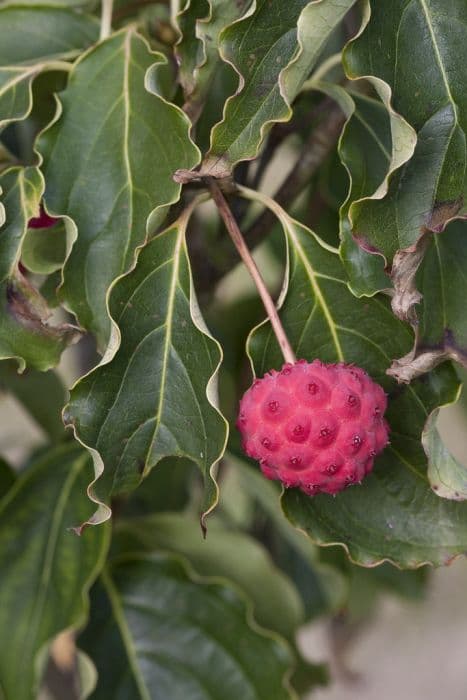

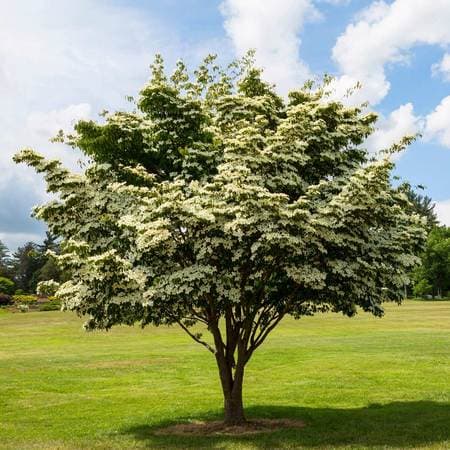
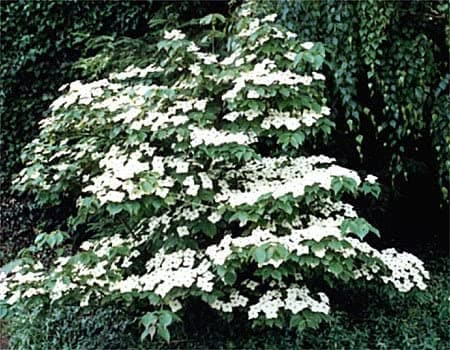

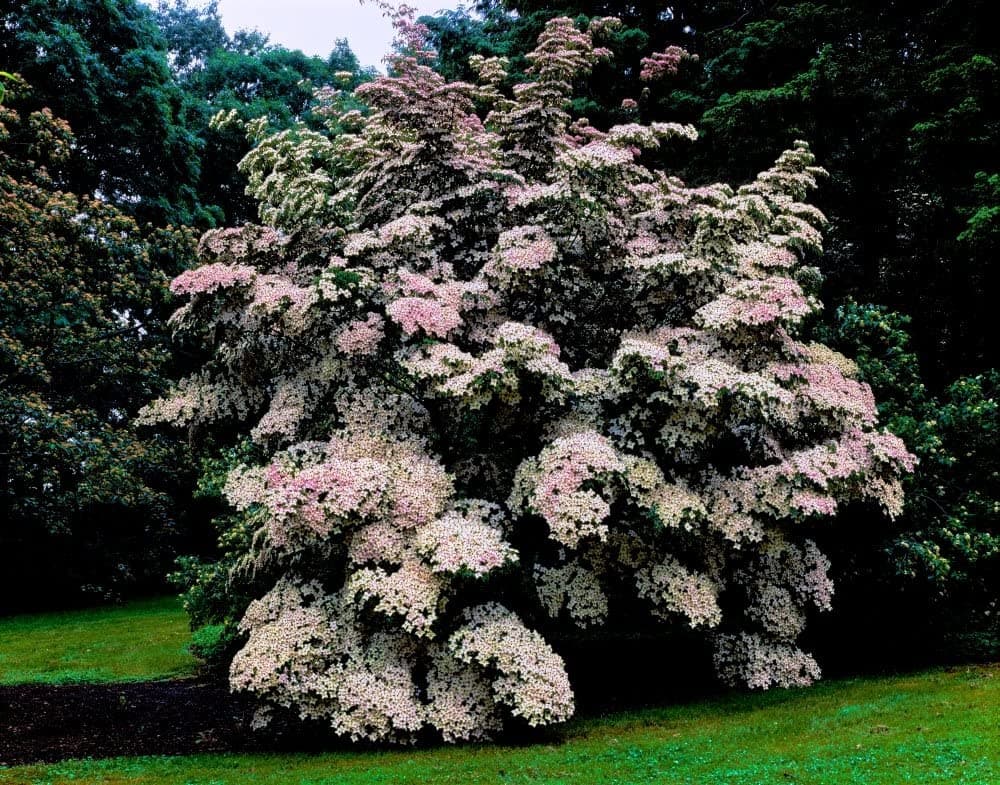
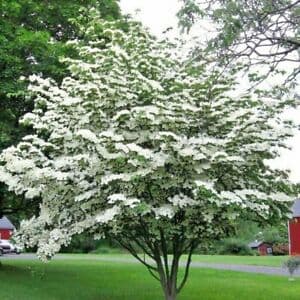
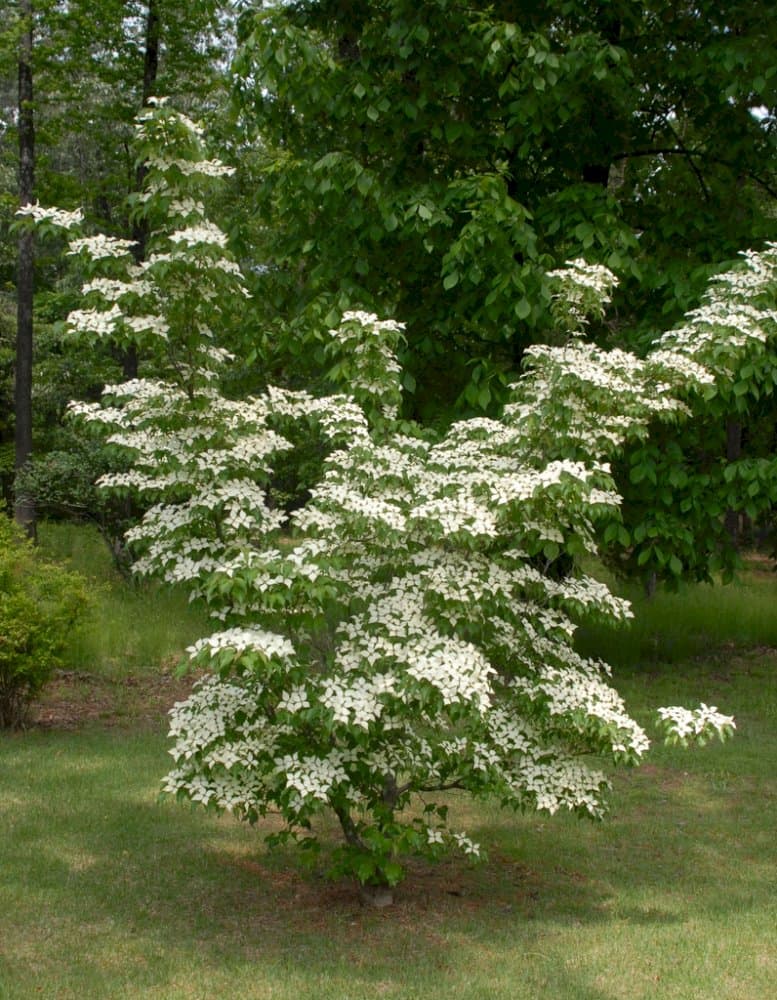
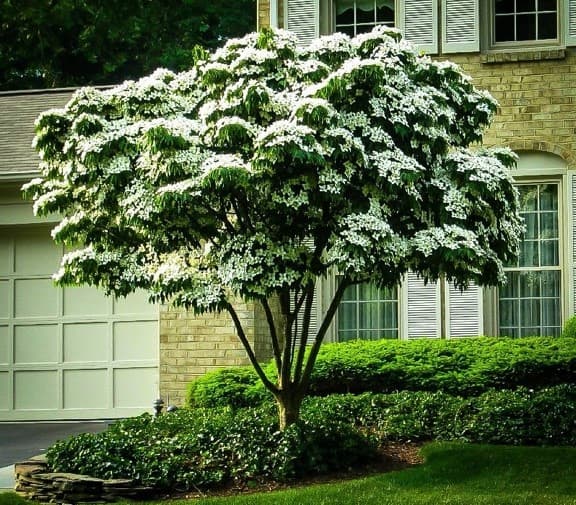
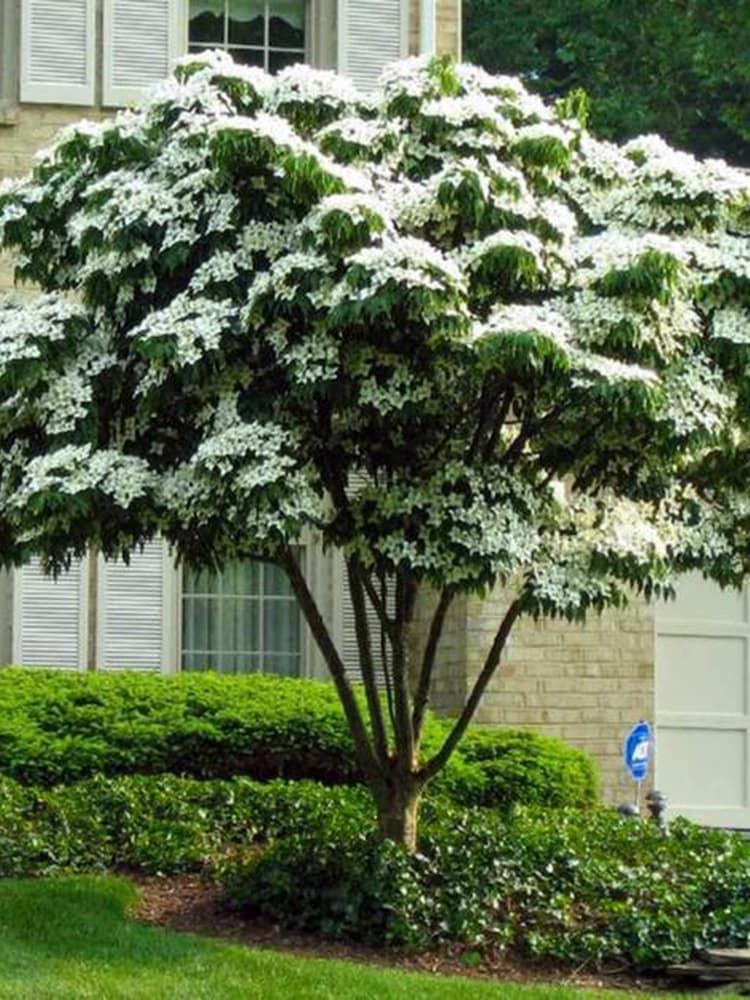
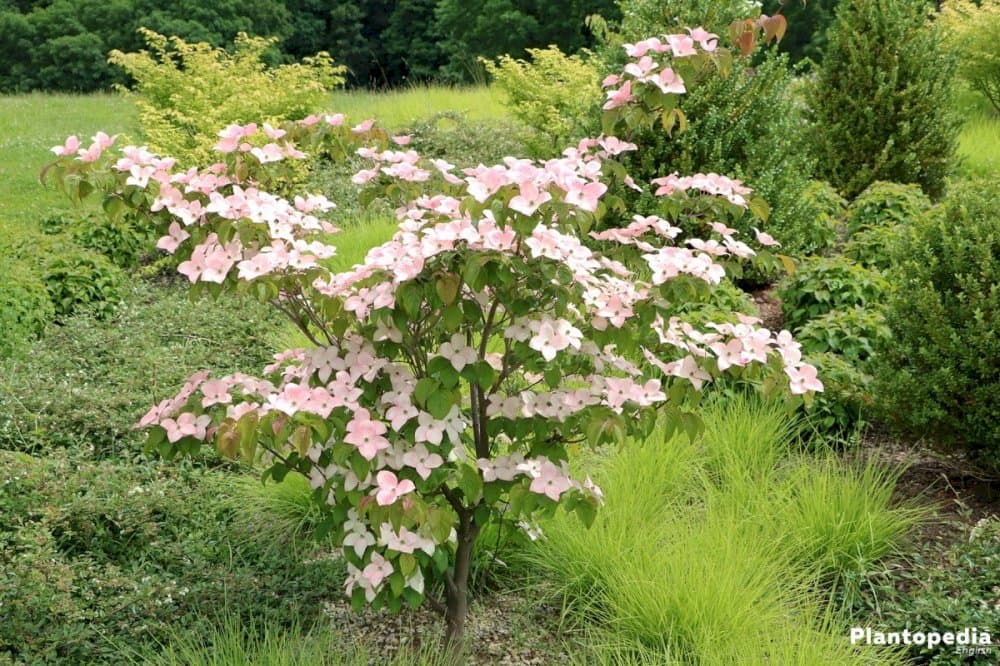
ABOUT
The Cornus kousa 'Bultinck's Giant', commonly known as the Kousa Dogwood, exhibits an appealing aesthetic that is cherished in many gardens. Noted for its showy nature, this ornamental tree blooms profusely with star-shaped flowers that are initially a soft green and blossom into a brilliant white as they mature. Its flowering bracts, which are often mistaken for petals, elegantly surround the tiny, central true flowers. After the flowering season, the Kousa Dogwood produces berry-like fruits that are a deep pinkish-red hue and can attract a variety of birds and wildlife. The leaves of the Kousa Dogwood are ovate to lanceolate in shape with pointed tips, possessing a rich green color that transitions to spectacular shades of red and purple in the fall, creating a stunning display. The bark has a distinctive mottled appearance, peeling in patterns that reveal gray, brown, and sometimes tan shades beneath, contributing to its visual interest throughout the year. The plant's structure is characterized by a rounded form, with branches that spread elegantly to create a canopy that offers dappled shade underneath. The overall impression of the Kousa Dogwood is of a plant full of ornamental value, with a charming appearance that evolves beautifully across the seasons.
About this plant
 Names
NamesFamily
Cornaceae.
Synonyms
Kousa Dogwood, Chinese Dogwood, Japanese Dogwood, Korean Dogwood.
Common names
Cornus kousa 'Bultinck's Giant'.
 Toxicity
ToxicityTo humans
Kousa dogwood, commonly referred to in this cultivar as Cornus kousa 'Bultinck's Giant', is generally considered non-toxic to humans. The fruit of the kousa dogwood is edible and is sometimes used to make jams and wines. It does not typically cause poisoning or toxic reactions when consumed. However, as with any plant, individual allergies to the kousa dogwood could potentially occur, so any adverse reactions should be taken seriously, and medical advice should be sought if symptoms appear after ingestion.
To pets
Kousa dogwood, in its various cultivars including Cornus kousa 'Bultinck's Giant', is not known to be toxic to pets such as dogs and cats. The fruit of the kousa dogwood is edible, and although it is not common for pets to consume them, it is unlikely to result in poisoning. However, individual animals may have different sensitivities, and the ingestion of any non-food items can potentially cause gastrointestinal upset. If a pet shows symptoms of distress after consuming any part of this plant, it is advisable to consult a veterinarian.
 Characteristics
CharacteristicsLife cycle
Perennials
Foliage type
Deciduous
Color of leaves
Green
Flower color
White
Height
15-20 feet (4.6-6 meters)
Spread
15-20 feet (4.6-6 meters)
Plant type
Tree
Hardiness zones
5-8
Native area
Asia
Benefits
 General Benefits
General Benefits- Ornamental Appeal: The Cornus kousa 'Bultinck's Giant' features showy white flowers that bloom in late spring, adding aesthetic value to gardens and landscapes.
- Seasonal Interest: This plant offers year-round interest with flowers in spring, berry-like fruits in summer, and colorful foliage in fall.
- Wildlife Attraction: The fruits are a food source for birds and other wildlife, helping support local ecosystems.
- Disease Resistance: Kousa dogwood is more resistant to diseases such as dogwood anthracnose and powdery mildew compared to other dogwood species.
- Low Maintenance: Once established, this variety of dogwood typically requires minimal care, making it a great choice for both experienced and novice gardeners.
- Tolerates Shade: While it prefers a sunny location, it can also tolerate partial shade, offering flexibility in garden design.
- Urban Tolerant: Kousa dogwood can thrive in urban conditions, tolerating pollution and compacted soils better than many other trees.
 Medical Properties
Medical PropertiesThis plant is not used for medical purposes.
 Air-purifying Qualities
Air-purifying QualitiesThis plant is not specifically known for air purifying qualities.
 Other Uses
Other Uses- Cornus kousa's fruit can be used to make wine, offering a unique flavor distinct from traditional grape wines.
- The wood of the Kousa dogwood is hard and shock-resistant, making it suitable for crafting small items like tool handles or shuttle bobbins for textiles.
- The tree can be trained into a bonsai form, creating a miniature version for enthusiasts to enjoy its ornamental beauty up close.
- Its dense branching pattern provides excellent cover for birds, making it ideal for use in creating natural bird sanctuaries and habitats.
- Kousa dogwood blossoms can be used in floral arrangements, especially during springtime, for their unique and striking appearance.
- The leaves turn a vibrant red in the fall, making them a natural dye source for fabrics or crafts.
- Kousa dogwood can be planted as a living fence or privacy screen, offering both beauty and function to landscapes.
- The patterned bark can be used in photography or artistic projects, where its unique texture offers an appealing visual element.
- The tree's fallen leaves provide a valuable addition to compost piles, enriching the resulting soil with essential nutrients.
- The ornamental fruit, while not widely consumed, can be used to create jams or jellies with a distinct, exotic taste.
Interesting Facts
 Feng Shui
Feng ShuiThe Kousa Dogwood is not used in Feng Shui practice.
 Zodiac Sign Compitability
Zodiac Sign CompitabilityThe Kousa Dogwood is not used in astrology practice.
 Plant Symbolism
Plant Symbolism- Protection: Cornus kousa, commonly known as Kousa dogwood, features a tough exterior bark and resilient nature, which are often associated with strength and the ability to shield from harm.
- Purity: The white bracts that are often mistaken for flowers resemble purity and cleanliness, symbolizing clarity and innocence.
- Renewal: Celebrated for its ability to bloom in late spring to early summer, the Kousa dogwood represents rebirth and the renewal of life, similar to many other trees that flower as the seasons change.
- Hope: Their ability to withstand challenging conditions, coupled with their vibrant bloom after a harsh winter, makes them a symbol of hope and endurance.
 Water
WaterThe Chinese Dogwood, or Cornus kousa 'Bultinck's Giant', should be watered deeply and thoroughly, with a particular emphasis on maintaining moist but not soggy soil. In the absence of rainfall, water the plant once a week with approximately 1 to 1.5 gallons of water; this may be adjusted depending on the season and weather conditions. During the first growing season, establish a strong root system with regular watering, but once established, the Chinese Dogwood is relatively drought tolerant. Always check the soil moisture level a few inches deep before watering to prevent over-watering.
 Light
LightThe Chinese Dogwood thrives best in conditions where it can receive full sun to partial shade. Ideally, plant it in a spot where it can be bathed in morning sunlight but protected from the harsh afternoon sun, which can be crucial during hot summer months. The dappled shade would also be a suitable location for this variety of dogwood, ensuring it receives ample light without the risk of leaf scorch.
 Temperature
TemperatureThe Chinese Dogwood is adaptable to a range of temperatures but generally prefers to grow in conditions where the temperature is between 60°F and 75°F. It can tolerate a minimum temperature down to about -20°F, making it suitable for USDA hardiness zones 5 through 8. Extreme heat and cold should be avoided, and the plant should be protected from severe winter winds.
 Pruning
PruningPruning the Chinese Dogwood should be done to maintain its shape, remove any dead or broken branches, and encourage healthy growth. The best time for pruning is late winter or early spring before the new growth starts. It isn't necessary to prune every year; you may do so every two to three years or as needed to tidy up the plant's appearance.
 Cleaning
CleaningAs needed
 Soil
SoilKousa Dogwood thrives best in organically rich, well-draining soil with a pH of 5.5 to 6.5. A mix incorporating equal parts loam, peat, and sand or perlite is ideal to ensure proper drainage and aeration while retaining some moisture.
 Repotting
RepottingKousa Dogwood doesn't require frequent repotting; it should be transplanted into the landscape rather than repotted. In its youth, if grown in a container, it may need repotting every 2-3 years.
 Humidity & Misting
Humidity & MistingKousa Dogwood prefers average humidity levels, typical of what is found outdoors in its natural environment. There's no need to supplement humidity when planted outside in its hardiness range.
 Suitable locations
Suitable locationsIndoor
Position near a sunny window, water regularly.
Outdoor
Plant in part shade to full sun, water and mulch.
Hardiness zone
5-8 USDA
 Life cycle
Life cycleThe life of Cornus kousa 'Bultinck's Giant', commonly known as Kousa dogwood, begins with seed germination, occurring in spring to early summer, requiring a period of cold stratification to break dormancy. The seedling stage involves initial root and shoot development, with the appearance of the true leaves indicating successful establishment. As the plant enters the vegetative stage, it develops a strong root system and woody stems, with foliage growth leading to a characteristic vase-shaped form. The Kousa dogwood reaches maturity after several years, entering the reproductive stage, characterized by the production of white to pinkish bracts that bloom in late spring to early summer, encircling the small greenish-yellow flowers. Following pollination, the plant bears fruit in the form of red berries, which mature by late summer to fall and are distributed by wildlife, facilitating the spread of seeds. The plant then cycles through a period of dormancy in winter, with leaves dropping, before resuming growth in the next spring.
 Propogation
PropogationPropogation time
Spring-Early Summer
The most popular method of propagation for the Kousa dogwood, including the 'Bultinck's Giant' cultivar, is by seed. To propagate by seed, you should collect the fruit in autumn once fully ripe and extract the seeds by cleaning away the fruit pulp. It's essential to stratify the seeds by giving them a period of cold treatment to break dormancy, typically by mixing them with moist sand and storing them in the refrigerator (about 34–39 degrees Fahrenheit or 1–4 degrees Celsius) for 90 to 120 days. After stratification, the seeds can be sown in pots or a prepared seedbed in spring, covering them lightly with soil. Germination can be slow and irregular, but once sprouted, seedlings grow best with protection from harsh sun and wind, in well-draining, fertile soil.
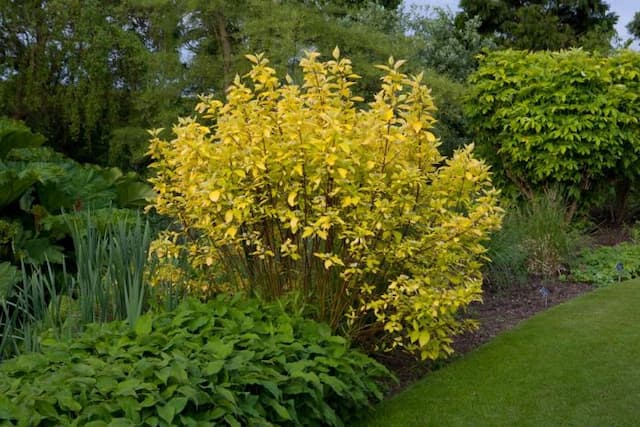
![Dogwood [Baton Rouge]](/_next/image?url=https%3A%2F%2Fplants-admin.emdemapps.com%2Fimages%2Fplants%2F%2Fimages%2F604b59cf0fefd.png&w=640&q=75)
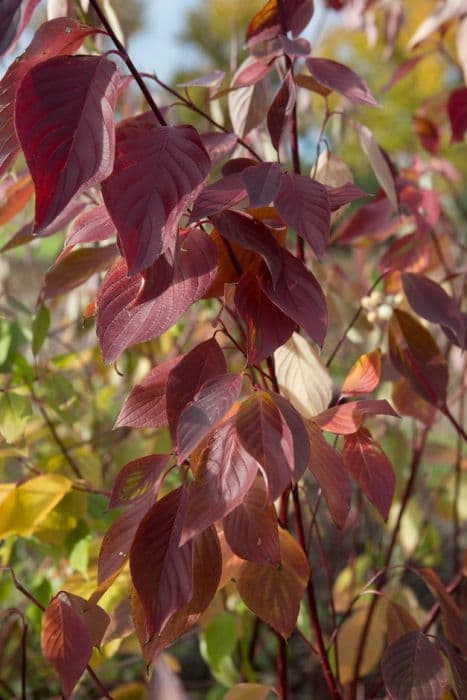
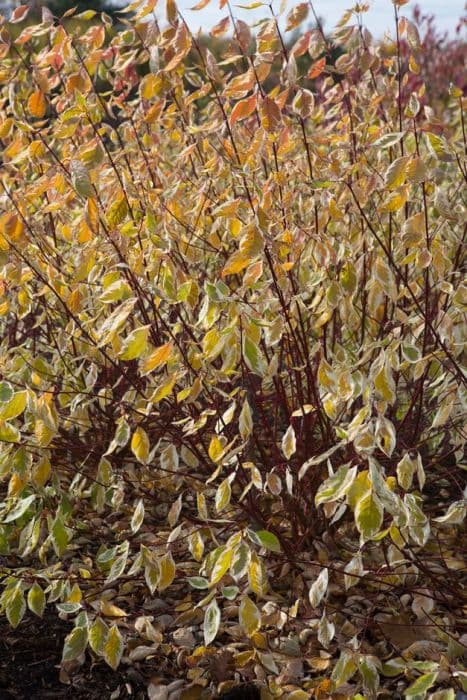
![Dogwood [Ivory Halo]](/_next/image?url=https%3A%2F%2Fplants-admin.emdemapps.com%2Fimages%2Fplants%2F%2Fimages%2F604b535cbcb9a.png&w=640&q=75)




